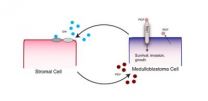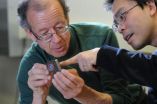(Press-News.org) The bacteria that cause acne live on everyone's skin, yet one in five people is lucky enough to develop only an occasional pimple over a lifetime. What's their secret?
In a boon for teenagers everywhere, a UCLA study conducted with researchers at Washington University in St. Louis and the Los Angeles Biomedical Research Institute has discovered that acne bacteria contain "bad" strains associated with pimples and "good" strains that may protect the skin.
The findings, published in the Feb. 28 edition of the Journal of Investigative Dermatology, could lead to a myriad of new therapies to prevent and treat the disfiguring skin disorder.
"We learned that not all acne bacteria trigger pimples — one strain may help keep skin healthy," said principal investigator Huiying Li, an assistant professor of molecular and medical pharmacology at the David Geffen School of Medicine at UCLA. "We hope to apply our findings to develop new strategies that stop blemishes before they start, and enable dermatologists to customize treatment to each patient's unique cocktail of skin bacteria."
The scientists looked at a tiny microbe with a big name: Propionibacterium acnes, bacteria that thrive in the oily depths of our pores. When the bacteria aggravate the immune system, they cause the swollen, red bumps associated with acne.
Using over-the-counter pore-cleansing strips, LA BioMed and UCLA researchers lifted P. acnes bacteria from the noses of 49 pimply and 52 clear-skinned volunteers. After extracting the microbial DNA from the strips, Li's laboratory tracked a genetic marker to identify the
bacterial strains in each volunteer's pores and recorded whether the person suffered from acne.
Next, Li's lab cultured the bacteria from the strips to isolate more than 1,000 strains. Washington University scientists sequenced the genomes of 66 of the P. acnes strains, enabling UCLA co-first author Shuta Tomida to zero in on genes unique to each strain.
"We were interested to learn that the bacterial strains looked very different when taken from diseased skin, compared to healthy skin," said co-author Dr. Noah Craft, a dermatologist and director of the Center for Immunotherapeutics Research at LA BioMed at Harbor–UCLA Medical Center. "Two unique strains of P. acnes appeared in one out of five volunteers with acne but rarely occurred in clear-skinned people."
The biggest discovery was still to come.
"We were extremely excited to uncover a third strain of P. acnes that's common in healthy skin yet rarely found when acne is present," said Li, who is also a member of UCLA's Crump Institute for Molecular Imaging. "We suspect that this strain contains a natural defense mechanism that enables it to recognize attackers and destroy them before they infect the bacterial cell."
Offering new hope to acne sufferers, the researchers believe that increasing the body's friendly strain of P. acnes through the use of a simple cream or lotion may help calm spotty complexions.
"This P. acnes strain may protect the skin, much like yogurt's live bacteria help defend the gut from harmful bugs," Li said. "Our next step will be to investigate whether a probiotic cream can block bad bacteria from invading the skin and prevent pimples before they start."
Additional studies will focus on exploring new drugs that kill bad strains of P. acnes while preserving the good ones; the use of viruses to kill acne-related bacteria; and a simple skin test to predict whether a person will develop aggressive acne in the future.
"Our research underscores the importance of strain-level analysis of the world of human microbes to define the role of bacteria in health and disease," said George Weinstock, associate director of the Genome Institute and professor of genetics at Washington University in St. Louis. "This type of analysis has a much higher resolution than prior studies that relied on bacterial cultures or only made distinctions between bacterial species."
Acne affects 80 percent of Americans at some point in their lives, yet scientists know little about what causes the disorder and have made limited progress in developing new strategies for treating it. Dermatologists' arsenal of anti-acne tools — benzoyl peroxide, antibiotics and Accutane (isotretinoin) — hasn't expanded in decades. Most severe cases of acne don't respond to antibiotics, and Accutane can produce serious side effects.
###
The research was supported by a grant (UH2AR057503) from the National Institutes of Health's Human Microbiome Project through the National Institute of Arthritis and Musculoskeletal and Skin Diseases.
Co-authors include co-first author Sorel Fitz-Gibbon, Bor-Han Chiu, Lin Nguyen, Christine Du, Dr. Minghsun Liu, David Elashoff, Dr. Jenny Kim, Anya Loncaric, Dr. Robert Modlin and Jeff F. Miller of UCLA; Erica Sodergren of Washington University; and Dr. Marie Erfe of LA BioMed.
UCLA: Elaine Schmidt, eschmidt@mednet.ucla.edu
310-794-2272
Washington University: Caroline Arbanas, arbanasc@wustl.edu
314-286-0109
LA BioMed: Laura Mecoy, lmecoy@labiomed.org
310-546-5860 END
UCLA study could explain why some people get zits and others don't
2 strains of acne bacteria linked to pimples, another to healthy skin
2013-02-28
ELSE PRESS RELEASES FROM THIS DATE:
Action video games boost reading skills
2013-02-28
Much to the chagrin of parents who think their kids should spend less time playing video games and more time studying, time spent playing action video games can actually make dyslexic children read better. In fact, 12 hours of video game play did more for reading skills than is normally achieved with a year of spontaneous reading development or demanding traditional reading treatments.
The evidence, appearing in the Cell Press journal Current Biology on February 28, follows from earlier work by the same team linking dyslexia to early problems with visual attention rather ...
Fighting GM crop vandalism with a government-protected research site
2013-02-28
Genetically modified (GM) crops have been a source of great controversy—particularly in Europe—but acts of vandalism and associated security costs have made scientific evidence about the health and ecological impacts of those crops hard to come by. A Swiss government-protected field site dedicated for use in GM crop studies could serve as an example to other European countries interested in pursuing crop biotechnology, according to an article published in Trends in Biotechnology, a Cell Press publication, on February 28.
The protected field site will now enable research ...
Study identifies growth factor essential to the most common malignant pediatric brain tumor
2013-02-28
A multi-institutional team led by Massachusetts General Hospital (MGH) researchers has identified a molecular pathway that appears to be essential for the growth and spread of medulloblastoma, the most common malignant brain tumor in children. In their report in the Feb. 28 issue of Cell, they show that blocking this pathway – which involves interactions between tumor cells and the surrounding tissues – leads to regression of all four molecular subtypes of medulloblastoma in several mouse models.
"Our finding that a pathway carrying signals from host cells to tumor cells ...
How did early primordial cells evolve?
2013-02-28
VIDEO:
L-form bacteria undergoes cell division. The time scale is in minutes.
Click here for more information.
Four billion years ago, soon after the planet cooled enough for life to begin, primordial cells may have replicated and divided without protein machinery or cell walls, relying instead on just a flimsy lipid membrane. New research on bacteria examines exactly how these primitive cells could have evolved without such crucial structures. While the vast majority of bacteria ...
Animas' development of a first-generation closed loop insulin delivery system progresses
2013-02-28
WEST CHESTER, Pa., February 28, 2013 – Animas Corporation announced today positive results from the second phase of human clinical trials of a first-generation, closed-loop insulin delivery system in development, designed to predict a rise or fall in blood glucose and correspondingly increase, decrease, suspend and resume insulin delivery. The data were presented at the Advanced Technologies & Treatments for Diabetes (ATTD) Conference in Paris, France.
The feasibility study of the predictive Hypoglycemia-Hyperglycemia Minimizer (HHM) System* in development was conducted ...
The birth of a giant planet?
2013-02-28
An international team led by Sascha Quanz (ETH Zurich, Switzerland) has studied the disc of gas and dust that surrounds the young star HD 100546, a relatively nearby neighbour located 335 light-years from Earth. They were surprised to find what seems to be a planet in the process of being formed, still embedded in the disc of material around the young star. The candidate planet would be a gas giant similar to Jupiter.
"So far, planet formation has mostly been a topic tackled by computer simulations," says Sascha Quanz. "If our discovery is indeed a forming planet, then ...
Secondary facelift achieves good results, reports plastic and reconstructive surgery
2013-02-28
Philadelphia, Pa. (February 28, 2013) – Performed an average of a decade after initial facelift surgery, a "secondary" facelift can achieve similarly lasting results with a low complication rate, according to a paper in the March issue of Plastic and Reconstructive Surgery®, the official medical journal of the American Society of Plastic Surgeons (ASPS).
Dr. Rod J. Rohrich and colleagues of University of Southwestern Medical Center, Dallas, report their 20-year experience with secondary facelift surgery, or "rhytidectomy." The researchers conclude that, with attention ...
Round or 'shaped,' implants yield good results in breast reconstruction
2013-02-28
Philadelphia, Pa. (February 28, 2013) –For women undergoing breast reconstruction using implants, most patient-reported outcomes are similar with two different shapes of silicone gel-filled implants, reports a study in the March issue of Plastic and Reconstructive Surgery®, the official medical journal of the American Society of Plastic Surgeons (ASPS).
Assessment of key areas of quality of life after breast reconstruction shows few significant differences with conventional round implants versus newer "shaped" implants, according to the new research, led by Dr. Sheina ...
Progesterone may be why pregnant women are more vulnerable to certain infections
2013-02-28
Bethesda, MD—Women who are pregnant or using synthetic progesterone birth control injections have a conspicuous vulnerability to certain infections including malaria, Listeria, HIV, and herpes simplex virus. A new research report appearing in the March 2013 issue of the Journal of Leukocyte Biology offers strong evidence for a possible explanation: the progesterone receptor, a pregnancy hormone sensor, targets a part of the immune system responsible for protection against these and other invaders. In addition to helping explain why some women are more vulnerable to certain ...
Brown unveils novel wireless brain sensor
2013-02-28
PROVIDENCE, R.I. [Brown University] — A team of neuroengineers based at Brown University has developed a fully implantable and rechargeable wireless brain sensor capable of relaying real-time broadband signals from up to 100 neurons in freely moving subjects. Several copies of the novel low-power device, described in the Journal of Neural Engineering, have been performing well in animal models for more than year, a first in the brain-computer interface field. Brain-computer interfaces coud help people with severe paralysis control devces with their thoughts.
Arto Nurmikko, ...
LAST 30 PRESS RELEASES:
Scalable and healable gradient textiles for multi‑scenario radiative cooling via bicomponent blow spinning
Research shows informed traders never let a good climate crisis go to waste
Intelligent XGBoost framework enhances asphalt pavement skid resistance assessment
Dual-function biomaterials for postoperative osteosarcoma: Tumor suppression and bone regeneration
New framework reveals where transport emissions concentrate in Singapore
NTP-enhanced lattice oxygen activation in Ce-Co catalysts for low-temperature soot combustion
Synergistic interface engineering in Cu-Zn-Ce catalysts for efficient CO2 hydrogenation to methanol
COVID-19 leaves a lasting mark on the human brain
Scientists use ultrasound to soften and treat cancer tumors without damaging healthy tissue
Community swimming program for Black youth boosts skills, sense of belonging, study finds
Specific depressive symptoms in midlife linked to increased dementia risk
An ‘illuminating’ design sheds light on cholesterol
Who is more likely to get long COVID?
Study showcases resilience and rapid growth of “living rocks”
Naval Research Lab diver earns Office of Naval Research 2025 Sailor of the Year
New Mayo-led study establishes practical definition for rapidly progressive dementia
Fossil fuel industry’s “climate false solutions” reinforce its power and aggravate environmental injustice
Researchers reveal bias in a widely used measure of algorithm performance
Alcohol causes cancer. A study from IOCB Prague confirms damage to DNA and shows how cells defend against it
Hidden viruses in wastewater treatment may shape public health risks, study finds
Unlock the power of nature: how biomass can transform climate mitigation
Biochar reshapes hidden soil microbes that capture carbon dioxide in farmland
Reducing saturated fat intake shows mortality benefit, but only in high-risk individuals
Manta rays create mobile ecosystems, study finds
Study: Mixed results in using lipoic acid to treat progressive multiple sclerosis
Norbert Holtkamp appointed director of Fermi National Accelerator Laboratory
New agentic AI platform accelerates advanced optics design
Biologists discover neurons use physical signals — not electricity — to stabilize communication
Researchers discover that a hormone can access the brain by hitchhiking
University of Oklahoma researcher awarded funding to pursue AI-powered material design
[Press-News.org] UCLA study could explain why some people get zits and others don't2 strains of acne bacteria linked to pimples, another to healthy skin




